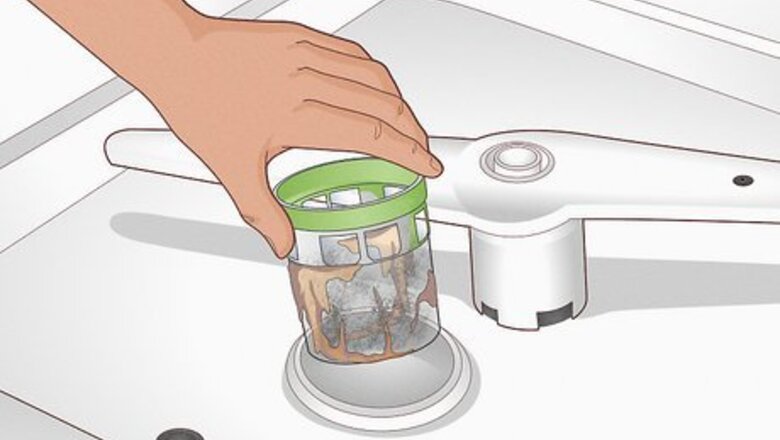
views
- To fix a clogged filter, remove and clean the mesh filter in the bottom of your dishwasher with soap and water.
- If the spray arm is clogged, clean out the spray arm in the bottom of your dishwasher with a toothpick, then rinse it with warm water.
- Use high quality detergent and a rinse agent to get rid of water spots and leave your dishes sparkling clean.
The filter is clogged.
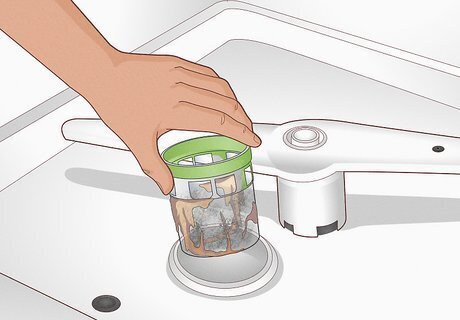
A clogged filter can cause your dishwasher to run poorly. Unless your dishwasher is self-cleaning, it probably has a small mesh filter in the bottom that you can untwist and take out. Remove the filter, then clean it using a sponge and some dish soap before putting it back in. Your dishwasher will probably run better than ever! Check inside of the cavity where the filter sits, too, and remove any food particles or debris by hand. Can’t find your filter? Check the owner’s manual for specific instructions.
The spray arm is clogged.
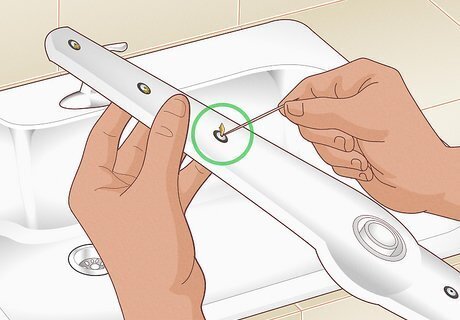
Clean the spray arm so water can shoot out efficiently. Look at the bottom of your dishwasher where the spray arm is located. Pop the spray arm out by either loosening the screw cap or simply snapping it off. Then, use a toothpick to clear out the small holes before rinsing with hot water. To reinstall the spray arm, simply snap it back into place. If you had to loosen a screw cap, tighten that back up before running a cycle.
The water temperature is too low.
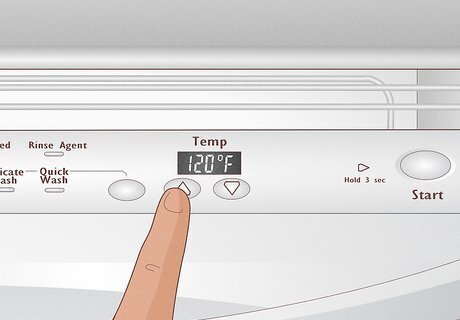
Make sure the water temperature is at least 120 °F (49 °C). If the water in your dishwasher is too cold, it won’t clean your dishes as effectively. Check the temperature sensor on your dishwasher if it has one, or make sure your hot water heater is set to at least 120 °F (49 °C). If the problem continues, try running hot water in your kitchen sink for about 30 seconds before you start every new wash cycle. This will heat up the water faster and ensure that only hot water goes into your dishwasher.
Your dishwasher is dirty.
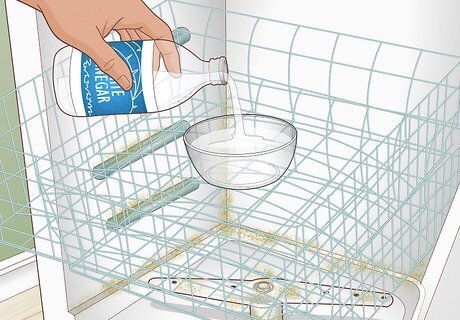
Use vinegar to deodorize and disinfect your dishwasher. We don’t think about it often, but the inside of a dishwasher can get dirty, too! If you’ve never cleaned your dishwasher before, pour 1 c (240 mL) of white vinegar into a bowl and place it on the top rack of your empty dishwasher. Run the hottest cycle your dishwasher has, then open the door and let the whole thing air dry. Vinegar is great at removing any built up residue inside of your dishwasher, which is probably left over from food scraps or hard water.
Your dishes aren’t loaded correctly.
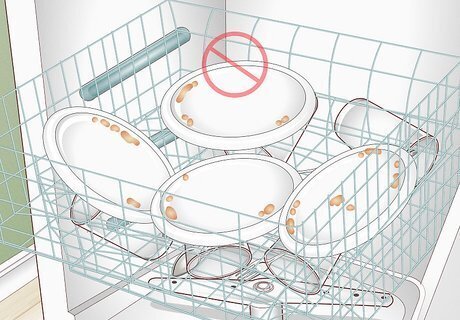
Optimize your loading technique to clean dishes effectively. It might seem like the easiest thing in the world, but there actually is a wrong way to load dishes. Use the top rack for cups, glasses, and bowls, and save the bottom rack for plates, serving bowls, and other large items. Place silverware carefully into the silverware basket, and make sure forks and spoons aren’t stuck together before a cycle. Loading dishes the right way ensures that the water and detergent reaches every dish. Overloading your dishwasher or loading it ineffectively can shield dishes from the hot water and soap inside. If you already do this, check your owner’s manual to see if the instructions differ. Sometimes, manufacturers recommend different loading techniques based on the size and structure of your dishwasher.
Your dishes have too much food on them.
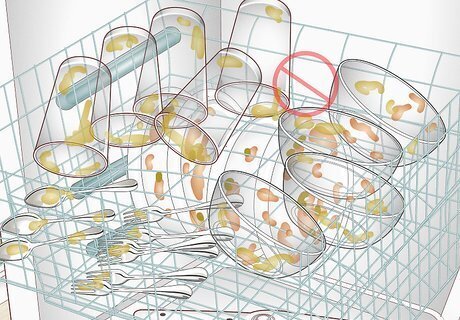
Get rid of large food scraps for a better clean. While modern dishwashers don’t require you to rinse beforehand, they still aren’t great at handling big pieces of food. If you’re dealing with plates of leftovers or bowls of breakfast, dump your dishes into the compost or trash before loading. If you have an older dishwasher, rinse your dishes before loading, too. Modern dishwashers have sensors in them to detect how dirty dishes are, but older ones lack this feature.
You’re not using the right cycle.
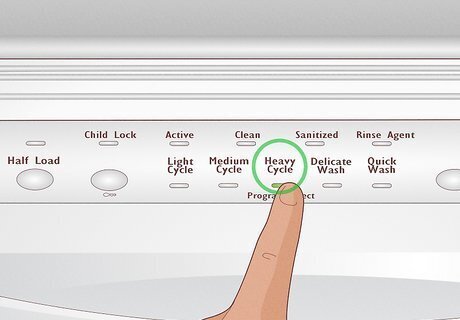
For very dirty dishes, use a heavier cycle. Light and medium cycles save time and water, but they don’t clean as effectively. If you’re loading up a lot of dishes that are all very dirty, select the heaviest cycle your dishwasher has for maximum efficiency. If your dishwasher has any added heat options, use those as well. This will heat up the water even more, leading to cleaner dishes.
You’re using low-quality detergent.

Use high-quality detergent for a deep clean. Look for detergents that contain enzymes and rinse aids for that sparkling clean finish. You can use liquid detergent, detergent packs, or detergent gels—whatever you’d like! Check out some of the top-rated detergents from Consumer Reports, like: Cascade ActionPacs with Dawn Finish Powerball Quantum Great Value Dishwasher Gel Cascade Gel with Dawn
Your dishes aren’t getting rinsed wel.
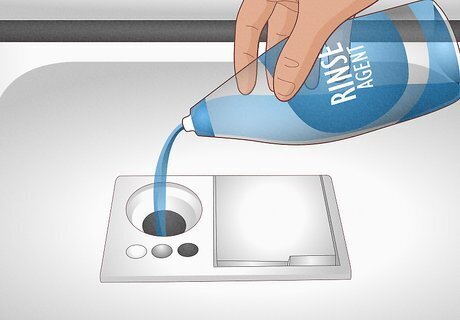
Use a rinse agent to leave dishes sparkling clean. If you’re dealing with cloudy or dull dishes, a rinse agent is the perfect product for you. Simply add some rinse agent to your dishwasher’s rinse aid reservoir before each cycle to help keep your dishes clean. Rinse agents contain surfactants, which help remove water droplets quickly so they can’t leave spots. Rinse agents also help get rid of residue left behind from hard water.
Hard water is leaving residue.
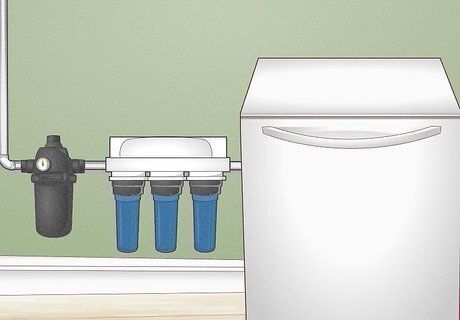
If you have hard water, install a water softener. Hard water tends to leave residue on your dishes, which can make them look cloudy or dusty. If you have hard water, consider installing a water softener on the water line in your home. This will help keep your dishes clean and also avoid hard water buildup elsewhere, like in your shower or sink faucets. Not sure if you have hard water? Use a hardness test kit to test your home’s water. Installing a water softener usually requires help from a professional, and can cost anywhere from $150 to $600.
The inlet valve is broken.
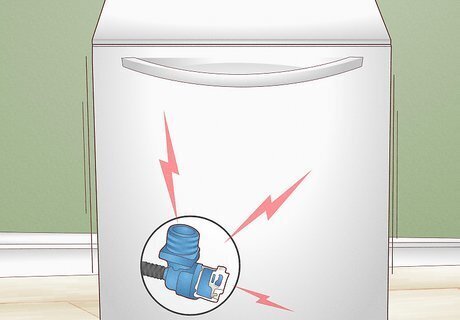
If you hear a hammering sound, your inlet valve could be broken. Sometimes, even after troubleshooting and trying new techniques, your dishwasher still won’t clean your dishes. If you’ve tried multiple things and you’re also hearing a hammering noise while the dishwasher is on, your inlet valve (which lets water flow into the machine) may be damaged. Contact a professional to come take a look and potentially replace the inlet valve. A broken inlet valve can also cause your dishwasher to leak.




















Comments
0 comment